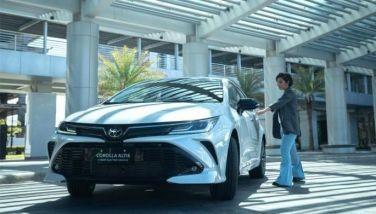Much ado about ‘2-stroke’
November 20, 2002 | 12:00am
Don’t discriminate on the technology. Just focus on compliance.
This in a nutshell is what local motorcycle manufacturers are asking from government agencies as they appeal for consideration over the planned phase out of two-stroke tricycles in Metro Manila and other parts of the country.
In its separate letters to different government agencies, the members of the Motorcycle Development Program Participants Association (MDPPA) said the full implementation of RA 8749, more popularly known as the Clean Air Act, next year has created confusion and panic within the automotive industry, particularly among motorcycle users in the country.
The MDPPA noted that if the law is fully implemented, starting next year, new motorcycles will not be registered without Certificate of Conformity (CoC) on the Clean Air Act. To get such certificate, a motorcycle must have a maximum 4.5 percent carbon monoxide emission, a standard specified in the law’s implementing rules and regulations.
However, some implementers of the law are generalizing against two-stroke motorcycles, based mainly on the impression that their engines emit a higher level of carbon monoxide.
The MDPPA is strongly countering this generalization.
"Agencies must not differentiate two-stroke engines from four-stroke engines but instead focus on the full compliance to emission standards," said Mateo Ocenar, MDPPA president. "They must focus on the violators of the law – not on the technology."
Ocenar pointed out that the recently issued resolution number 02-36 of the Metropolitan Manila Development Authority (MMDA) is "unreasonable and discriminatory." The said resolution urges heads of local government units, meaning Metro Manila mayors, to implement a moratorium on the granting of franchise to new two-stroke tricycles.
"We in the industry find this resolution unreasonable and discriminatory because in the first place the tricycle franchise should not be used as a basis for compliance to emission standards since it is not part of the requirement under the Clean Air Act," said Ocenar.
Ocenar explained that in other countries in Southeast Asia such as Thailand and Indonesia which have larger motorcycle population, governments do not differentiate between two-stroke and four-stroke engines. "Their approach is compliance to standards. Even developed countries such as Japan, which have very stringent emission laws, are not biased on two-stroke engines as long as they pass the emission standards."
Based on estimates, two-stroke engines power more than two-thirds of the country’s two million motorcycles. Most of these two-stroke bikes are used for commercial purposes, mainly as principal mode of transportation in the provinces and in numerous subdivisions and villages in major towns and cities.
Because of their popularity among the less privileged, two-stroke engines have been tagged as the poor man’s engine. They are cheap, light, and packs almost double the power than their four-stroke counterparts.
The Tricycle Operators and Drivers Association-Pilipinas (TODAP), in a position paper, said thousands of its members would surely suffer once the moratorium in the issuance of franchises takes effect.
At a press forum late last week, TODAP vice president Severino del Rosario warned of mass unemployment among tricycle drivers all over the country if the government pushes through with its plan to ban two-stroke tricycles.
"There should be a reasonable phaseout period," he said, adding that a three- to five-year timeframe might be enough to allow owners of two-stroke motorcycles to generate enough money to invest on four-stroke bikes.
Two-stroke engines are named such because unlike traditional internal combustion engines, it only takes two strokes to complete one combustion cycle. They are commonly found in lower-power applications, such as lawn mowers, chain saws, dirt bikes, mopeds, jet skis and radio-controlled model planes. These engines have three important advantages over four-stroke engines, namely:
• They do not have valves, which simplifies their construction and lowers their weight.
• They fire only once every revolution, while four-stroke engines fire once every other revolution. This gives them a significant power boost.
• They can work in any orientation, which can be important in something like a chainsaw. A standard four-stroke engine may have problems with oil flow unless it is upright, and solving this problem can add complexity to the engine.
These advantages make two-stroke engines lighter, simpler and less expensive to manufacture. Two-stroke engines also have the potential to pack about twice the power into the same space because there are twice as many power strokes per revolution.
However, two-stroke engines are seldom used in cars and bigger vehicles. That’s because they have a couple of significant disadvantages:
• They don’t last nearly as long as four-stroke engines. The lack of a dedicated lubrication system means that the parts of a two-stroke engine wear a lot faster.
• The oil is expensive and the engines seldom use fuel efficiently, so you would get lower mileage per liter.
The MDPPA is urging agencies such as the MMDA, the Department of Environment and Natural Resources (DENR) and local government units (LGUs) to focus more on the compliance of motorcycle owners to the emission standards.
Initially, it wrote the DENR a different letter requesting it to come up immediately with standards for motorcycles and tricycles so as to prevent LGUs from having different standards of their own.
In return, Ocenar said the entire motorcycle-making industry will educate motorcycle users in the proper engine maintenance to support the Clean Air Act.
"Although there is no correlation between the white smoke of two-stroke engines and hydrocarbons, we will still educate our end-users on how to reduce the white smoke," Ocenar said. "We too want clean air."
The MDPPA groups the five biggest motorcycle makers in the country, namely Honda, Kawasaki, Kymco, Suzuki and Yamaha. Based on its studies, the group estimates that more than three million people depend on motorcycles for their livelihood. And based on its remittances yearly, the MDPPA boasts of contributing some P4 billion in taxes, registration fees and salaries to workers.
Ocenar stressed that the industry is fast adapting to changes in the world, with many of its members now developing four-stroke motorcycle models and looking for ways to make two-stroke engines more efficient. As a matter of fact, he said majority of the MDPPA’s members now have four-stroke models that are now available in the market. These models will be displayed in a motorcycle show set late next week in Cebu.
"We will get to that point soon," he said. "But in the meantime, let’s not ban the two-stroke technology but rather institute compliance to emission standards as embodied in the Clean Air Act."
This in a nutshell is what local motorcycle manufacturers are asking from government agencies as they appeal for consideration over the planned phase out of two-stroke tricycles in Metro Manila and other parts of the country.
In its separate letters to different government agencies, the members of the Motorcycle Development Program Participants Association (MDPPA) said the full implementation of RA 8749, more popularly known as the Clean Air Act, next year has created confusion and panic within the automotive industry, particularly among motorcycle users in the country.
The MDPPA noted that if the law is fully implemented, starting next year, new motorcycles will not be registered without Certificate of Conformity (CoC) on the Clean Air Act. To get such certificate, a motorcycle must have a maximum 4.5 percent carbon monoxide emission, a standard specified in the law’s implementing rules and regulations.
However, some implementers of the law are generalizing against two-stroke motorcycles, based mainly on the impression that their engines emit a higher level of carbon monoxide.
The MDPPA is strongly countering this generalization.
"Agencies must not differentiate two-stroke engines from four-stroke engines but instead focus on the full compliance to emission standards," said Mateo Ocenar, MDPPA president. "They must focus on the violators of the law – not on the technology."
Ocenar pointed out that the recently issued resolution number 02-36 of the Metropolitan Manila Development Authority (MMDA) is "unreasonable and discriminatory." The said resolution urges heads of local government units, meaning Metro Manila mayors, to implement a moratorium on the granting of franchise to new two-stroke tricycles.
"We in the industry find this resolution unreasonable and discriminatory because in the first place the tricycle franchise should not be used as a basis for compliance to emission standards since it is not part of the requirement under the Clean Air Act," said Ocenar.
Ocenar explained that in other countries in Southeast Asia such as Thailand and Indonesia which have larger motorcycle population, governments do not differentiate between two-stroke and four-stroke engines. "Their approach is compliance to standards. Even developed countries such as Japan, which have very stringent emission laws, are not biased on two-stroke engines as long as they pass the emission standards."
Because of their popularity among the less privileged, two-stroke engines have been tagged as the poor man’s engine. They are cheap, light, and packs almost double the power than their four-stroke counterparts.
The Tricycle Operators and Drivers Association-Pilipinas (TODAP), in a position paper, said thousands of its members would surely suffer once the moratorium in the issuance of franchises takes effect.
At a press forum late last week, TODAP vice president Severino del Rosario warned of mass unemployment among tricycle drivers all over the country if the government pushes through with its plan to ban two-stroke tricycles.
"There should be a reasonable phaseout period," he said, adding that a three- to five-year timeframe might be enough to allow owners of two-stroke motorcycles to generate enough money to invest on four-stroke bikes.
• They do not have valves, which simplifies their construction and lowers their weight.
• They fire only once every revolution, while four-stroke engines fire once every other revolution. This gives them a significant power boost.
• They can work in any orientation, which can be important in something like a chainsaw. A standard four-stroke engine may have problems with oil flow unless it is upright, and solving this problem can add complexity to the engine.
These advantages make two-stroke engines lighter, simpler and less expensive to manufacture. Two-stroke engines also have the potential to pack about twice the power into the same space because there are twice as many power strokes per revolution.
However, two-stroke engines are seldom used in cars and bigger vehicles. That’s because they have a couple of significant disadvantages:
• They don’t last nearly as long as four-stroke engines. The lack of a dedicated lubrication system means that the parts of a two-stroke engine wear a lot faster.
• The oil is expensive and the engines seldom use fuel efficiently, so you would get lower mileage per liter.
Initially, it wrote the DENR a different letter requesting it to come up immediately with standards for motorcycles and tricycles so as to prevent LGUs from having different standards of their own.
In return, Ocenar said the entire motorcycle-making industry will educate motorcycle users in the proper engine maintenance to support the Clean Air Act.
"Although there is no correlation between the white smoke of two-stroke engines and hydrocarbons, we will still educate our end-users on how to reduce the white smoke," Ocenar said. "We too want clean air."
The MDPPA groups the five biggest motorcycle makers in the country, namely Honda, Kawasaki, Kymco, Suzuki and Yamaha. Based on its studies, the group estimates that more than three million people depend on motorcycles for their livelihood. And based on its remittances yearly, the MDPPA boasts of contributing some P4 billion in taxes, registration fees and salaries to workers.
Ocenar stressed that the industry is fast adapting to changes in the world, with many of its members now developing four-stroke motorcycle models and looking for ways to make two-stroke engines more efficient. As a matter of fact, he said majority of the MDPPA’s members now have four-stroke models that are now available in the market. These models will be displayed in a motorcycle show set late next week in Cebu.
"We will get to that point soon," he said. "But in the meantime, let’s not ban the two-stroke technology but rather institute compliance to emission standards as embodied in the Clean Air Act."
BrandSpace Articles
<
>
- Latest
Latest
Latest
September 30, 2024 - 4:26pm
By EC Toledo | September 30, 2024 - 4:26pm
September 26, 2024 - 3:30pm
September 26, 2024 - 3:30pm
August 16, 2024 - 11:00am
By Euden Valdez | August 16, 2024 - 11:00am
Recommended
January 10, 2025 - 12:00am



























